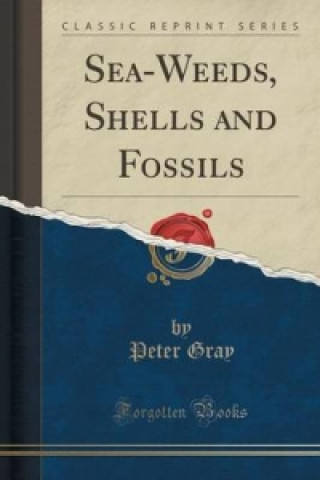
Code: 09464147
Sea-Weeds, Shells and Fossils (Classic Reprint)
by Peter Gray
Excerpt from Sea-Weeds, Shells and Fossils Algć, popularly known as sea-weeds, although many species are inhabitants of fresh water, or grow on moist ground, may be briefly described as cellular, flowerless plants, having no pr ... more
- Language:
 English
English - Binding: Paperback
- Number of pages: 134
Publisher: Forgotten Books, 2015
- More about this

You might also like
-

Dune
34.84 zł -33 % -

Haunting Adeline
125.81 zł -1 % -

Berserk Deluxe Volume 2
212.65 zł -1 % -

White Nights
15.40 zł -23 % -

Powerless
47.24 zł -14 % -

Atomic Habits
59.22 zł -26 % -

Dune Messiah
46.33 zł -3 % -

Berserk Deluxe Volume 3
215.07 zł -1 % -

One Day
32.63 zł -36 % -

Berserk Deluxe Volume 1
211.84 zł -2 % -

Iron Flame
62.95 zł -26 % -

Surrounded by Idiots
37.77 zł -26 % -

Harry Potter and the Prisoner of Azkaban (Minalima Edition)
170.44 zł -2 % -

Gravity Falls Journal 3
89.45 zł -

Heaven Official's Blessing: Tian Guan Ci Fu (Novel) Vol. 1
89.04 zł -1 % -

The Creative Act
100.22 zł -15 % -

Dune
47.34 zł -23 % -

Hunting Adeline
126.52 zł -4 % -

A Little Life
47.24 zł -14 % -

Children of Dune
46.73 zł -2 % -

Heaven Official's Blessing: Tian Guan Ci Fu (Novel) Vol. 2
86.73 zł -3 %
Availability alert
Enter your e-mail address and once book will be available,
we will send you a message. It's that simple.
More about Sea-Weeds, Shells and Fossils (Classic Reprint)
 Book synopsis
Book synopsis
Excerpt from Sea-Weeds, Shells and Fossils Algć, popularly known as sea-weeds, although many species are inhabitants of fresh water, or grow on moist ground, may be briefly described as cellular, flowerless plants, having no proper roots, but imbibing nutrients by their whole surface from the medium in which they grow. As far as has been ascertained, the total number of species is about 9000 or 10,000. Many of them are microscopic, as the Desmids and Diatoms, others, as Lessonia, and some of the larger Laminarise (oarweeds), are arborescent, covering the bed of the sea around the coast with a submarine forest; while in the Pacific, off the northwestern shores of America, Nereocystis, a genus allied to Laminaria, has a stem over 300 feet in length, which, although not thicker than whipcord, is stout enough to moor a bladder, barrel-shaped, six or seven feet long, and crowned with a tuft of fifty leaves or more, each from thirty to forty feet in length. This vegetable buoy is a favourite resting place of the sea otter; and where the plant exists in any quantity, the surface of the sea is rendered impassable to boats. The stem of Macrocystis, which "girds the globe in the southern temperate zone," is stated to extend sometimes to the enormous length of 1500 feet. It is no thicker than the finger anywhere, and the upper branches are as slender as pack-thread; but at the base of each leaf there is placed a buoy, in the shape of a vesicle filled with air. Although the worthlessness of Algć has been proverbial, as in the "alga inutile" of Horace and Virgil's "projecta vilior alga," they are not without importance in botanical economics. A dozen or more species found in the British seas are made use of, raw or prepared in several ways, as food for man. Of these edible Algć, Dr. Harvey considers the two species of Porphyra, or laver, the most valuable. About the Publisher Forgotten Books publishes hundreds of thousands of rare and classic books. Find more at www.forgottenbooks.com This book is a reproduction of an important historical work. Forgotten Books uses state-of-the-art technology to digitally reconstruct the work, preserving the original format whilst repairing imperfections present in the aged copy. In rare cases, an imperfection in the original, such as a blemish or missing page, may be replicated in our edition. We do, however, repair the vast majority of imperfections successfully; any imperfections that remain are intentionally left to preserve the state of such historical works.
 Book details
Book details
Book category Books in English Earth sciences, geography, environment, planning Earth sciences Geology & the lithosphere
- Full title: Sea-Weeds, Shells and Fossils (Classic Reprint)
- Author: Peter Gray
- Language:
 English
English - Binding: Paperback
- Number of pages: 134
- EAN: 9781330461754
- ISBN: 9781330461754
- ID: 09464147
- Publisher: Forgotten Books
- Weight: 191 g
- Dimensions: 229 × 152 × 7 mm
- Date of publishing: 12. June 2015
safisfied customers
Since 2008, we have served long line of book lovers, but each of them was always on the first place.
Copyright! ©2008-24 libristo.pl All rights reservedPrivacyPoučení o cookies



 21 million books
21 million books Delivery 12.99 zł
Delivery 12.99 zł (32) 444 93 66 (8-15.30h)
(32) 444 93 66 (8-15.30h)